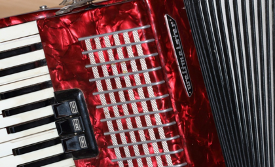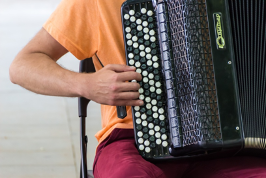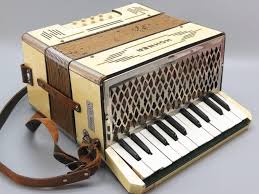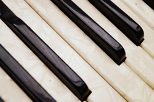What type of keyboards are there?
Depending upon the style of the accordion, there are a few different types of keyboards.
First, let’s make a distinction between the piano accordions and the button accordions. Piano accordions, as the name implies, possess a keyboard very similar to a piano. The button accordions, however, can be either chromatic or diatonic in nature, ranging from very small beginner accordions to large-scale sophisticated instruments. Played in a variety of regions around the world, button accordions possess -- you guessed it! -- buttons throughout the entire instrument. In this blog, I am going to briefly explain the keyboards on the piano accordion and on the chromatic button accordion.
Piano Accordion Keyboard

Why does one style of instrument seem to possess part of another instrument embedded into its design -- in this case, a piano-like keyboard? Well, it’s simply because a hand-held Handäoline in the 19th century was reengineered …and it worked! Then, at the beginning of the 20th century, the first professional accordion was built in Italy by the Ranco brothers. The piano accordion was the first standardized accordion and it was popularized across North America by Guido Deiro. Immediately, sheet music and literature from other keyboard instruments were adapted for this novel and portable design.
Chromatic Button Accordion

The keyboard on a chromatic button accordion use keys that looks like buttons. They’re built into the right hand side of the instrument. Chromatic buttons are rounded and, for the most part, are colored either black or white.
Of What Is A Keyboard Made?
A keyboard is a very complex system made of different elements, and all of these elements are specifically arranged to help musicians create nice-sounding tones. I’m an accordion teacher, not an accordion craftsman or repairman, so I will briefly mention some of these elements.
Keys: keys are usually white or black and made of a variety of synthetic or natural materials. Less expensive accordions possess keys that are made of plastic, whereas the more expensive instruments were once made from ivory.
Levers: The levers are metal parts upon which each key and each valve are placed. The levers are situated inside the accordion, out of sight.
Valves: The valves are small wooden plates placed at the end of a lever. These valves essentially open and close the holes beneath them. As the bellows expand and contract, air is forced through the holes while oscillating the reeds.
Size Of The Keyboard

As you might expect, the size of the keyboard usually depends upon the size of the accordion. Larger instruments possess a greater amount of keys, and smaller instruments possess a lesser amount of keys. For instance, a child’s accordions is usually made with 20 keys on the right hand side whereas a professional model ranges from 45 key to 47 keys on the right hand side.
